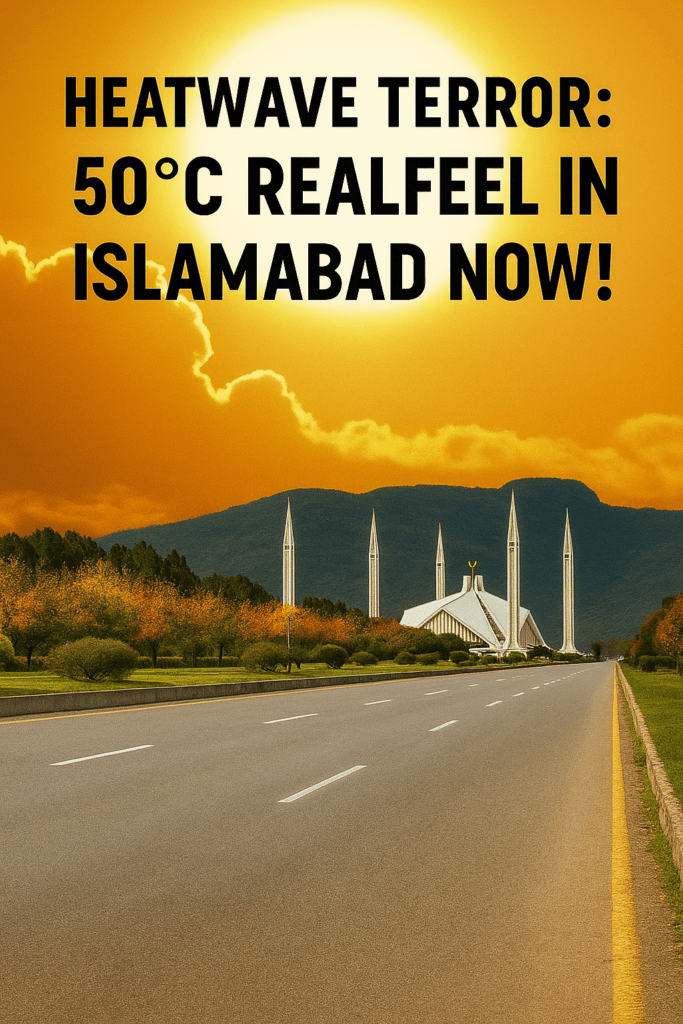
Islamabad is sweltering under a brutal heatwave, with temperatures soaring to a shocking 42°C, and the RealFeel—what your body actually feels—hitting a dangerous 50°C. The capital city is experiencing one of the most extreme weather spells in recent history, putting public health, power grids, and daily life under severe pressure.
⚠️ What Is RealFeel and Why It Matters?
The RealFeel temperature (also called heat index) is not just about the actual temperature—it includes humidity, wind, and sun intensity to reflect what the human body actually feels. So even if the thermometer reads 42°C, intense UV rays and stifling humidity push the RealFeel to a deadly 50°C.
Why is it dangerous?
- At 50°C RealFeel, heatstroke, dehydration, and fatigue become real threats.
- Outdoor work or walking can lead to serious health risks.
- Vulnerable groups like children, the elderly, and people with medical conditions are most at risk.
🌡️ Today’s Weather in Islamabad (June 20, 2025)
| Time | Temperature | RealFeel | Conditions |
|---|---|---|---|
| 1 PM | 42°C | 50°C | Hazy Sunshine |
| 3 PM | 41°C | 49°C | Humid, Sunny |
| 5 PM | 39°C | 46°C | Sunny |
| 7 PM | 37°C | 43°C | Clear Sky |
Humidity: 35-45%
UV Index: Very High (Extreme)
Wind: Mild breeze, no cooling relief
🧠 What’s Causing This Extreme Heat?
- Climate Change
Global warming has intensified regional heatwaves. Pakistan is among the top 10 countries most vulnerable to climate extremes. - Urban Heat Island Effect
Islamabad’s increasing concrete structures and reduced greenery cause heat to trap, making cities hotter than surrounding rural areas. - Monsoon Delay
With delayed monsoon rains, the pre-monsoon heat has intensified beyond average levels.
🚨 Health Risks of 50°C RealFeel
- Heatstroke: High body temperatures can damage organs.
- Dehydration: Rapid loss of fluids leads to fatigue and confusion.
- Respiratory Issues: Dust and humidity worsen asthma or allergies.
Symptoms to watch for:
- Dizziness or fainting
- Rapid heartbeat
- Nausea or vomiting
- No sweating despite heat
✅ Safety Tips: How to Survive This Heatwave
- Stay Indoors (11 AM – 4 PM)
Avoid direct sunlight during peak heat hours. - Hydrate Every Hour
Drink 2–3 liters of water, even if not thirsty. - Wear Light Cotton Clothes
White or light-colored, breathable fabrics are best. - Use Sunscreen & Umbrellas
Protect your skin from UV exposure. - Avoid Heavy Meals
Eat light, cold, and hydrating foods like cucumbers and yogurt.
🏥 Emergency Measures in Islamabad
- Hospitals on Alert: Major government hospitals have set up heatstroke response wards.
- Water Stations: Several NGOs and mosques have installed free drinking water booths.
- Load Shedding Concerns: K-Electric and IESCO urge people to limit electricity usage during peak hours.
📊 Is This the Hottest Islamabad Has Ever Been?
While not the highest recorded, the RealFeel of 50°C places this event among the top 5 hottest spells in Islamabad’s history. It rivals the deadly June 2015 heatwave in Karachi, which caused over 1,200 deaths.
🌎 What’s Next?
According to the Pakistan Meteorological Department (PMD):
- High temperatures will continue until June 24.
- Rain is expected by June 25, which may bring some relief.
🔔 PMD Advisory: Avoid non-essential outdoor activity, stay hydrated, and check on elderly neighbors.
Final Thoughts
This unprecedented heatwave in Islamabad is a wake-up call. Climate patterns are becoming harsher, and immediate steps are needed—from urban planning to public awareness—to adapt to this “new normal.”
🔴 If you feel unwell, seek medical help immediately. Share this article to help others stay safe during this dangerous spell.

